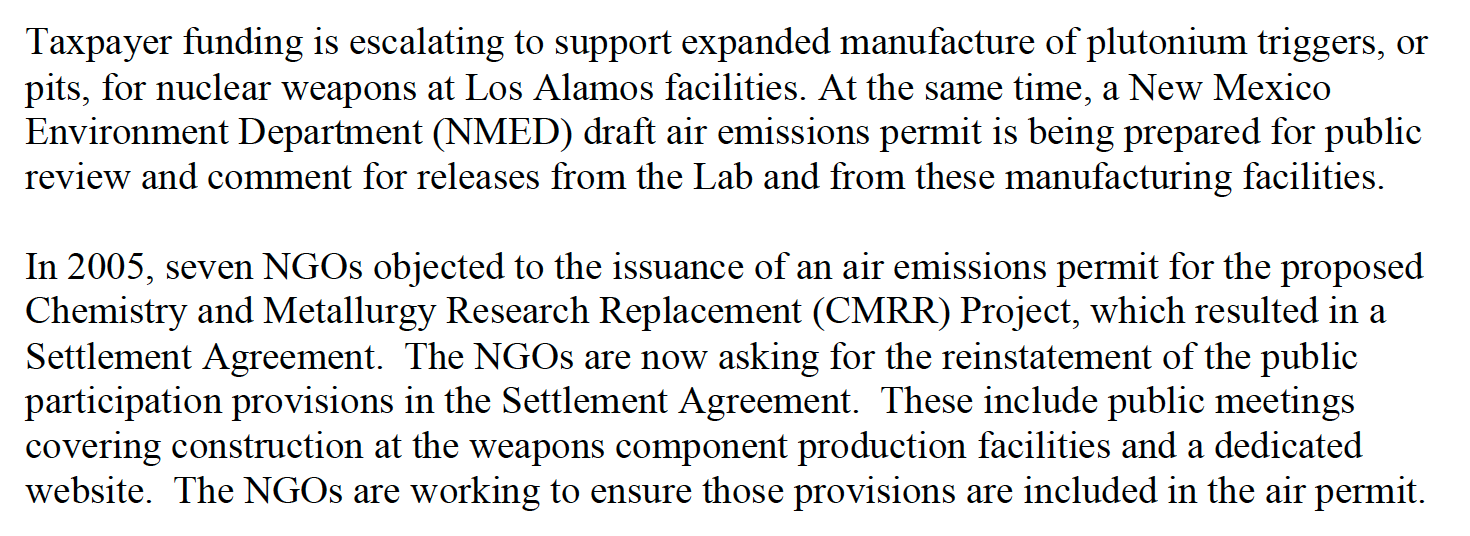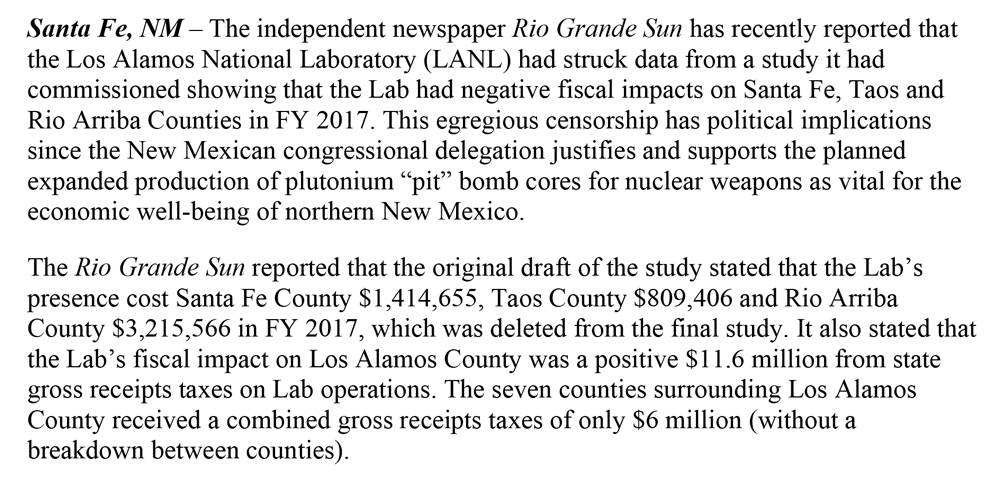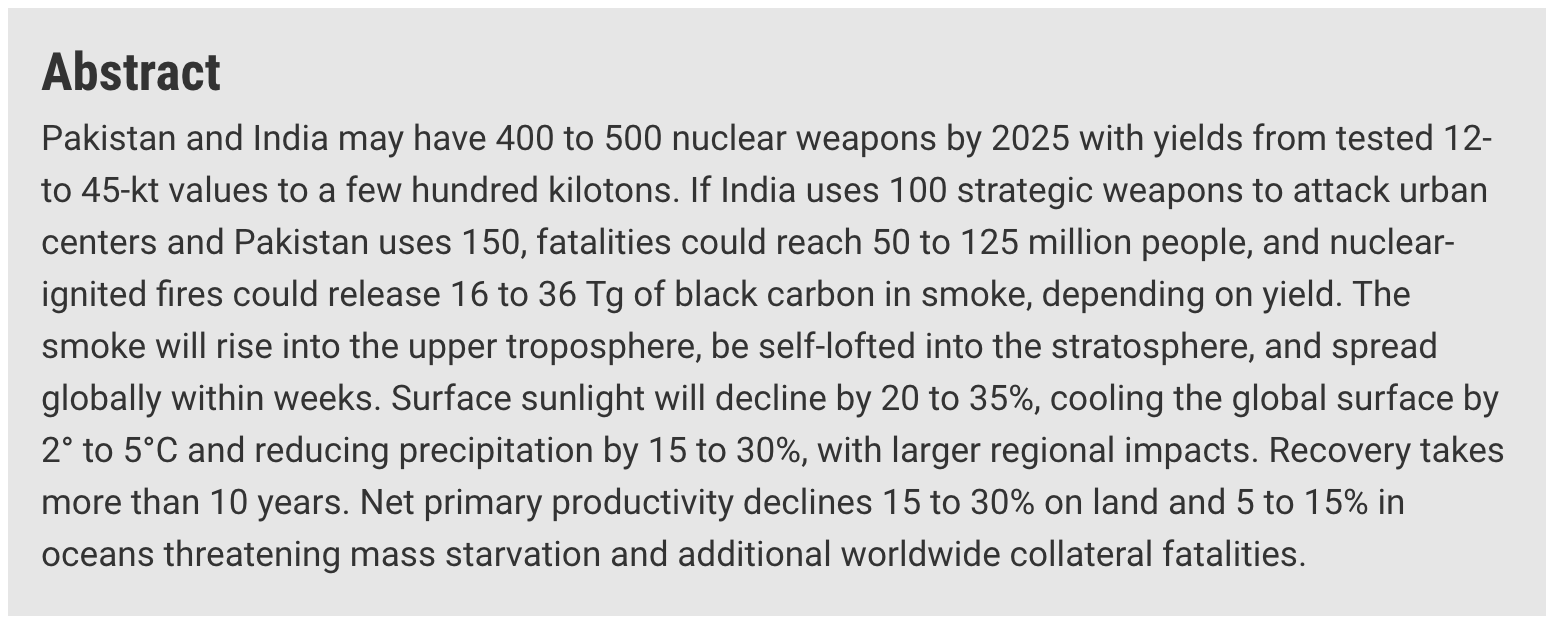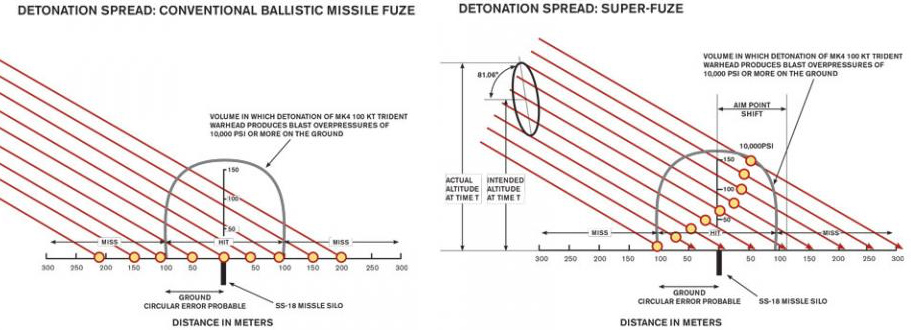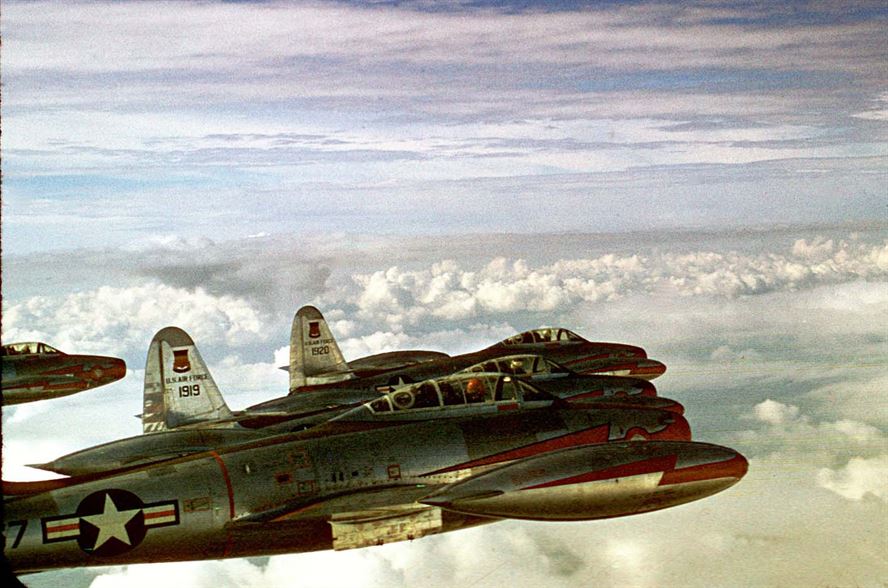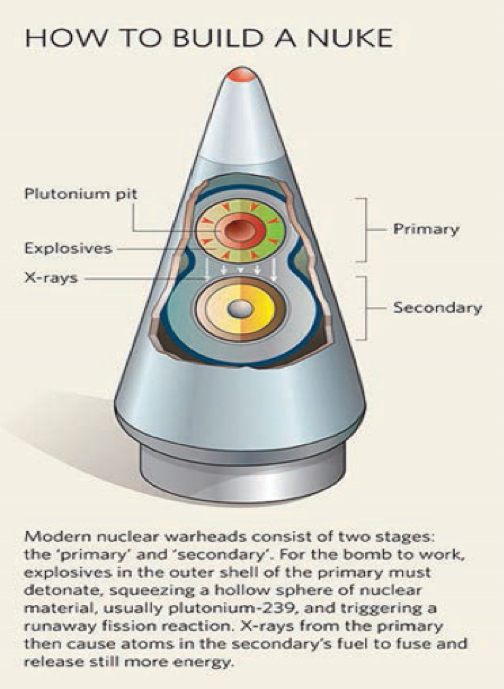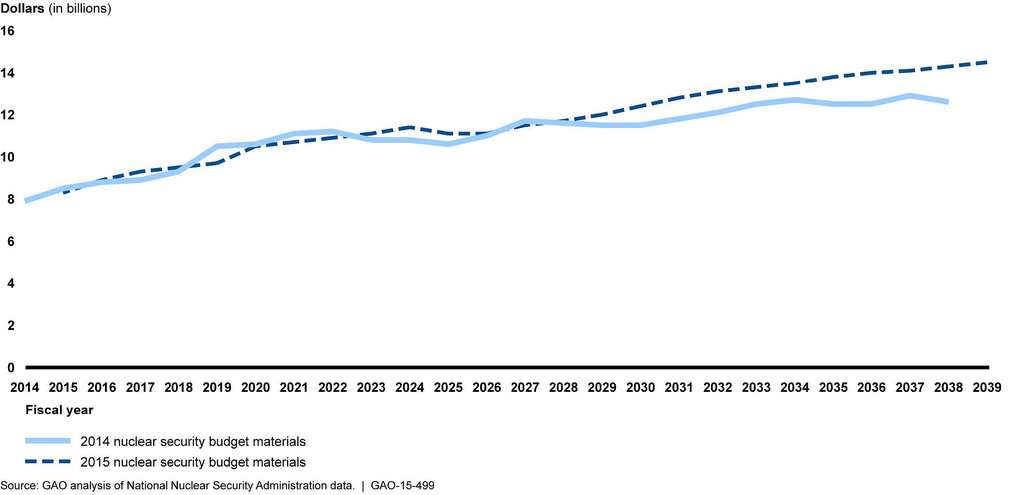2020
Trinity: “The most significant hazard of the entire Manhattan Project”
“New Mexico residents were neither warned before the 1945 Trinity blast, informed of health hazards afterward, nor evacuated before, during, or after the test. Exposure rates in public areas from the world’s first nuclear explosion were measured at levels 10,000- times higher than currently allowed.”
BY: KATHLEEN M. TUCKER & ROBERT ALVAREZ | thebulletin.org
For the past several years, the controversy over radioactive fallout from the world’s first atomic bomb explosion in Alamogordo, New Mexico on July 16, 1945—code-named Trinity—has intensified. Evidence collected by the New Mexico health department but ignored for some 70 years shows an unusually high rate of infant mortality in New Mexico counties downwind from the explosion and raises a serious question whether or not the first victims of the first atomic explosion might have been American children. Even though the first scientifically credible warnings about the hazards of radioactive fallout from a nuclear explosion had been made by 1940, historical records indicate a fallout team was not established until less than a month before the Trinity test, a hasty effort motivated primarily by concern over legal liability.
In October 1947, a local health care provider raised an alarm about infant deaths downwind of the Trinity test, bringing it to the attention of radiation safety experts working for the US nuclear weapons program. Their response misrepresented New Mexico’s then-unpublished data on health effects. Federal and New Mexico data indicate that between 1940 and 1960, infant death rates in the area downwind of the test site steadily declined—except for 1945, when the rate sharply increased, especially in the three months following the Trinity blast. The 21 kiloton explosion occurred on a tower 100 feet from the ground and has been likened to a “dirty bomb” that cast large amounts of heavily contaminated soil and debris—containing 80 percent of the bomb’s plutonium—over thousands of square-miles. (See Figure 1.)
‘Now I Am Become Death’: The Legacy of the First Nuclear Bomb Test
“Since the Trinity test 75 years ago, at least eight countries have conducted more than 2,000 nuclear bomb tests, said Jenifer Mackby, a senior fellow at the Federation of American Scientists. More than half of those tests have been conducted by the United States, a legacy of the Trinity explosion, as the United States and several other countries have continued to refuse to ratify the treaty prohibiting nuclear weapon test explosions.”
BY: MARIA CRAMER | nytimes.com
An aerial view of the aftermath of the first atomic explosion at the Trinity test site in New Mexico in 1945. The device exploded with a power equivalent to 21,000 tons of TNT. Credit Associated PressIt was 1 a.m. on July 16, 1945, when J. Robert Oppenheimer met with an Army lieutenant general, Leslie Groves, in the parched landscape of Jornada del Muerto — Dead Man’s Journey — a remote desert in New Mexico.
A group of engineers and physicists was about to detonate an atomic device packed with 13 pounds of plutonium, a nuclear weapon that the government hoped would bring an end to World War II.
Some scientists on the project worried that they were about to light the entire world on fire, according to researchers. Others worried that the test would be “a complete dud.”
Mr. Oppenheimer, who was tasked with designing an atomic bomb for the Manhattan Project, had not slept.
At 5:29 a.m. local time, the device exploded with a power equivalent to 21,000 tons of TNT and set off a flash of light that would have been visible from Mars, researchers said.
It was the first nuclear test in history.
Less than a month later, the United States would drop a nearly identical weapon on the city of Nagasaki in Japan.
In their own words: Trinity at 75
On July 16, 1945 the first nuclear bomb exploded near Alamogordo, New Mexico. The Trinity test marked the culmination of nearly four years of secret research led by an unprecedented collaboration of the world’s top scientists and the US military. It also guaranteed that the uranium gun-type weapon dropped on Hiroshima could be followed by another that used the plutonium implosion design tested at the Trinity Site. In essence, Trinity was a test-of-concept for the bomb that leveled Nagasaki.
The history of the Manhattan Project and the birth of the bomb have been examined and reexamined countless times over the past seven decades—as have the threats they posed to humanity.Though nearly all now are dead, many scientists, soldiers, and family members who attended the birth of the bomb documented their first-hand experiences in the pages of the Bulletin in a way that lives on, providing an exceptional and vivid glimpse of their struggles to achieve victory in war and science.
Read together, the eyewitness excerpts below offer a new retelling of the Trinity test, woven entirely from words that more than a dozen of the project’s protagonists first published in the Bulletin.
SUITABLE GROUND: ALAMOGORDO
Lt. Gen. Leslie R. Groves
Groves was the Army administrative officer in charge of the entire wartime Manhattan Project. Scientists at Los Alamos loathed his policy of “compartmentalization,” which aimed to isolate scientists to preserve secrecy.
In the early days, we believed that a gun-type bomb would be entirely satisfactory for both uranium-235 and for plutonium, and we did not feel that any full-scale test would be necessary. Later, when we learned that the gun-type would not be suitable for plutonium, we began to realize that we might find it advisable to test the implosion-type bomb. … As soon as a full-scale test—and it had to be full-scale—became likely, we began the search for a suitable testing ground.
Church Rock Uranium Spill July 16, 1979
In 1968, the United Nuclear Corporation initiated mining operations in the largest underground uranium mine in the United States. Located in Church Rock, New Mexico, in the Navajo Native American Reservation, the Church Rock Mill produced more than two million pounds of uranium oxide per year. Waste from the mining process was disposed of in three lined lagoons fortified by a man-made dam built on geologically unsound land—of which both the United Nuclear Corporation and state and federal agencies were aware. On 16 July, 1979, the dam breached and 1100 tons of uranium waste and 94 million gallons of radioactive water seeped into the Puerco River. Scientists estimate that the amount of radiation released in the Church Rock uranium mill spill was larger than the amount released at Three Mile Island, just four months prior. Surrounding residents of the mill, almost entirely Navajos, relied on the Puerco River as a watering source for livestock. They have since suffered severe health problems due to substantial increases in radioactivity found in the water, soil, and air. Despite several selective investigations and cleanup efforts by the US Environmental Protection Agency, ramifications of the spill remain evident in the Navajo Nation today.
From environmentandsociety.org
Interview with Larry King, who worked on-site at the United Nuclear Corporation mine the day of the tailings pond spill, and still lives in the area.
Church Rock SPECIAL Encore presentation on the 1979 #Radioactive #Uranium tailings pond spill in #NavajoNation that spread #Radiation thru 80 miles of the Puerco River & still hasn't been cleaned up. Interviews w/elders, activists, politicians. https://t.co/xvIcjd5jGu pic.twitter.com/MLQwY9BP2V
— Libbe HaLevy (@NuclearHotseat) July 14, 2020
Nuclear Hotseat Podcast episode on the Church Rock Spill
Escalation by Tweet: Managing the new nuclear diplomacy
Can a tweet start a nuclear war? New Report examines impact of Twitter on crisis escalation and recommends a “no tweeting policy” during crises.
[embeddoc url=”https://www.kcl.ac.uk/csss/assets/10957•twitterconflictreport-15july.pdf” download=”all” viewer=”google”]
Atomic Anniversary Brings U.S. Nuclear Official to New Mexico
“Los Alamos is facing of a 2026 deadline to begin producing at least 30 of the plutonium cores a year — a mission that has the support of the most senior Democratic members of New Mexico’s congressional delegation as the work is expected to bring jobs and billions of federal dollars to update buildings or construct new factories. The effort has drawn much criticism from watchdog groups that long have been concerned about the lab’s safety record, missed deadlines, repeated cost overruns and the pace of cleaning up contamination resulting from decades of bomb making and nuclear research.”
BY: SUSAN MONTOYA BRIAN | apnews.com
ALBUQUERQUE — The head of the National Nuclear Security Administration is in New Mexico this week as part of a nationwide tour of the federal government’s nuclear security operations.
The visit by Administrator Lisa Gordon-Hagerty coincides with the 75th anniversary of the Trinity test in Southern New Mexico, which marked the world’s first atomic blast on July 16, 1945. She’s scheduled to lead a commemoration Thursday at the historic V-Site at Los Alamos National Laboratory, where early testing and some assembly of the atomic bomb took place.
Gordon-Hagerty has been spearheading the federal government’s recent efforts to resume and ramp up production of the plutonium cores that are used to trigger nuclear weapons. The work will be split between Los Alamos and the Savannah River Site in South Carolina.
Trinity Downwinders: 75 Years and Waiting
Tularosa Basin Downwinders Consortium (TBDC)
REMEMBERING THE 75TH ANNIVERSARY OF THE TRINITY TEST
*** I M M E D I A T E P R E S S R E L E A S E ***
Thursday, July 16, 2020
Virtual Event at 9:00 a.m. MDT
Access at www.trinitydownwinders.com
Trinity Downwinders are commemorating the 75th Anniversary since the first nuclear test was conducted anywhere in the world and bringing attention to the fact that New Mexicans still have not received Radiation Exposure Compensation Act (RECA) benefits.

RECA was passed in 1990 by the US Government to provide health care coverage and compensation to downwinders from other parts of the country but has never included the people of New Mexico. The fund has paid out over 2.3 Billion Dollars in reparations to downwinders of the Nevada Test site but never to New Mexico downwinders. It also provides the best health care coverage available.
Trinity Downwinders will commemorate the New Mexicans who have died from cancer and other radiation exposure related diseases during this event and read firsthand accounts of the bomb blast.
Funding Nuclear Weapons at a Time of National Crisis
Nuclear weapons represent the greatest imminent existential threat to our very existence and to every social, racial, environmental and economic justice movement that we are working for, since ultimately it is all connected.
BY: ROBERT DODGE | cpmmondreams.com
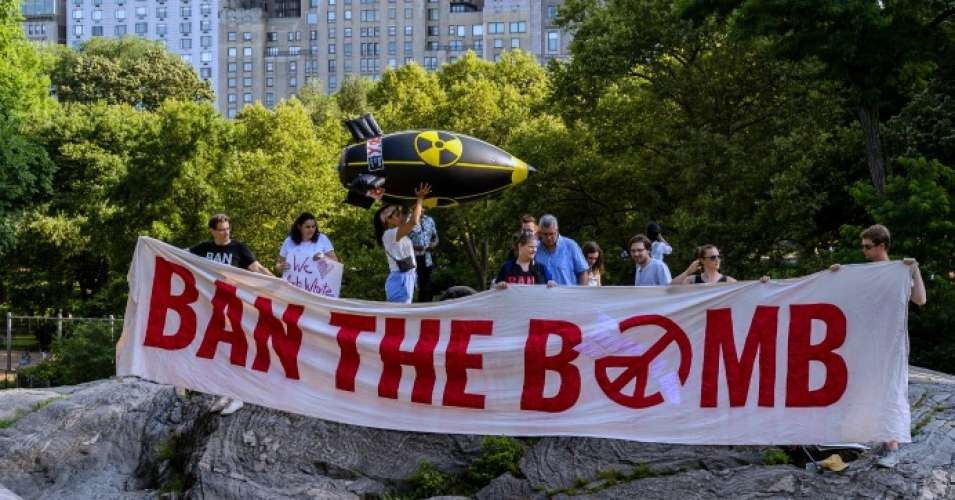
Today, July 15, we fund our nation’s priorities. This year, the nation is awakening to the problems of systemic and institutionalized racism while simultaneously grappling with the ongoing COVID-19 pandemic which has no end in sight. The Black Lives Matter movement is receiving its due attention and communities are demanding demilitarization of police forces and tactics and reprioritization of funding to address the needs of communities to bring forth a socially just, environmentally sustainable and peaceful community. City councils are taking a close look at police budgets and many citizens are calling for participatory budgeting with input in the budgets of their cities as they move to determine their own priorities. Nationally, with our massively bloated defense budget, it is also the time we fund the nuclear arms race even as nations around the world work to pass a nuclear ban treaty, the “Treaty on the Prohibition of Nuclear Weapons”, similar to those banning all other weapons of mass destruction.
“We knew the world would not be the same. A few people laughed, a few people cried, most people were silent. I remembered the line from the Hindu scripture, the Bhagavad-Gita. Vishnu is trying to persuade the Prince that he should do his duty and to impress him takes on his multi-armed form and says, “Now I am become Death, the destroyer of worlds. I suppose we all thought that, one way or another.”
Robert Oppenheimer on the Trinity test; interview in The Decision to Drop the Bomb, Atomic Archive movie
15 LANL Workers Tested for Radiation Exposure After Mishap
“Mishandled glove boxes are a long-standing problem at the lab, but having 15 workers possibly exposed to radiation because of one breach is a high number and could become more common as the plutonium plant ramps up production of nuclear cores.” — Scott Kovac, research and operations director for nonprofit Nuclear Watch New Mexico.
“The 15 workers is just an example of things to come,” Kovac said.
“The 15 workers is just an example of things to come,” Kovac said.
BY: SCOTT WYLAND | santafenewmexican.com
publicintegrity.org
Fifteen employees at Los Alamos National Laboratory’s plutonium plant were tested for radiation exposure after a “glove box” breach in June contaminated the work area.
Air monitors sounded an alarm at the facility when an operator accidentally ripped off the protective gloves attached to a sealed compartment for handling plutonium after the worker weighed and packaged plutonium-238 oxide powder.
The breach contaminated the worker’s protective clothing, hair and skin, and caused enough potential airborne exposure that other workers had to be tested for radiation, according to a report by the Defense Nuclear Facilities Safety Board.
July 10, 1985: The Bombing of the Rainbow Warrior
You can’t sink a Rainbow.
In 1985, French secret service agents planted two bombs and sank the Greenpeace ship the Rainbow Warrior. One crew member was killed. It was an instance when a government chose to respond to peaceful protest with deadly force. But peaceful protest has prevailed.
The Greenpeace ship Rainbow Warrior in Auckland Harbour, New Zealand, after being sunk by limpet mines planted by the French secret service.
10 July 1985. The Greenpeace ship the Rainbow Warrior is moored in Auckland, New Zealand – ready to confront French nuclear testing in the Moruroa Atoll.
Trump Plan to Build Nuclear Bombs Divides a Scarred Factory Town
“To me, they haven’t proven that this is going to be safe,” said Pete LaBerge, a 70-year-old retiree who lives about three miles away from the Savannah River Site in nearby Windsor, which has 150 residents. He worries about a release of radiation. “Part of my theory is it’s sort of a make-work program for the Energy Department.”
BY: ARI NATTER & CHARLIE MCGEE | bloomberg.com
A factory along South Carolina’s Savannah River produced tritium and plutonium for U.S. nuclear weapons during the Cold War, employing thousands of workers but leaving behind a toxic legacy of radioactive waste.
Now the Trump administration has proposed spending $9 billion over 10 years to restart production of bomb parts there and at another site. The plan has raised the welcome prospect of new jobs though also rekindled environmental fears. And it’s set off alarms about a new nuclear arms race just as key treaties with Russia lapse.
ABC NEWS FILE PHOTO Nov., 20, 2013, file photo, radioactive waste, sealed in large stainless steel canisters, are stored under a five-feet of concrete in a storage building at the Savannah River Site near Aiken, S.C.“It’s a waste of money and dangerous,” said Stephen Young, an expert on arms control and international security issues for the Union of Concerned Scientists.
President Donald Trump’s plan, announced by the departments of Energy and Defense in 2018, calls for restarting production of nuclear bomb ‘pits’ at the South Carolina site and another one in New Mexico. The bowling-ball sized spheres of plutonium act as the trigger in a nuclear warhead, setting off the explosive chain reaction.
WIPP: Nuclear Watchdog Group Again Challenges Utility Shaft in New Mexico Supreme Court
The Southwest Research and Information Center previously filed a motion to the court in April, seeking to block the New Mexico Environment Department’s (NMED) temporary approval (TA) of plans for the shaft that saw no public hearing or comment process.
BY: ADRIAN HEDDEN | carlsbadcurrentargus.com
The $100 million project to build the shaft was intended to increase airflow to the WIPP underground, where transuranic (TRU) waste is permanently disposed of, to allow emplacement of waste and mining of panels where it is emplaced to occur simultaneously.
A nuclear watchdog group in Albuquerque filed two appeals in New Mexico Supreme Court last week, seeking to block the construction of a utility shaft at the Waste Isolation Pilot Plant.
‘Will to fight together’: Fiji’s has taken another bold step in the battle against nuclear weapons
“For many in the Pacific, memories of the impact of nuclear weapons testing still exist, its legacies continue, and the Pacific-wide solidarity that started in Fiji carries lessons for the world.”
Ratification of United Nations treaty banning atomic weapons honours a half-century of anti-nuclear activism
By: Vanessa Griffen & Talei Luscia Mangioni | theguardian.com
The Against Testing on Mururoa (ATOM) committee protests on the streets of Suva, Fiji, in the 1970s Photograph: The GuardianIn the streets of Suva in the 1970s it was the young who carried the cause. In afros, headbands and bell-bottom jeans they handed out pamphlets and printed newsletters, performed skits and variety shows, gave lectures, and led rallies on the streets of Fiji’s capital.
Crowds heard firebrand speeches from church leaders, trade unionists, university staff and student leaders.
The Atom (Against Testing on Mururoa) committee, formed in Fiji in 1970, was dedicated to educating, creatively but powerfully, the Fijian public of the dangers of radioactive fallout from French testing and colonialism in the Pacific.
China Challenges the U.S. to Reduce Its Nuclear Arsenal to Same Level
BEIJING — If the United States were willing to reduce its nuclear arsenal to China’s level, China would “be happy to” participate in trilateral arms control negotiation with the U.S and Russia, a senior Chinese diplomat said on Wednesday.
REUTERS/NEW YORK TIMES | nytimes.com
The U.S. has repeatedly called for China to join in trilateral negotiations to extend a flagship nuclear arms treaty between the U.S. and Russia that is due to expire in February next year.
Fu Cong, head of arms control department of Chinese foreign ministry, reiterated to reporters in Beijing on Wednesday that China has no interest in joining the trilateral negotiation.
Senate Undoes Proposed Power Shift in Nuclear Arms Budgeting
Moves comes at the behest of the Energy secretary
BY: JOHN M. DONNELLY | rollcall.com
The Senate voted quietly Thursday to undo a proposal in its fiscal 2021 defense authorization bill that would have given the Pentagon extraordinary new power to shape the Energy Department’s future nuclear weapons budgets.
CQ Roll Call reported this week on behind-the-scenes opposition to provisions in the Senate Armed Services Committee’s version of the NDAA that would have given certain Defense Department officials new clout to set the amount and the content of the budget the Energy Department prepares for its National Nuclear Security Administration every year.
Appropriations Committee Releases Fiscal Year 2021 Energy and Water Development Funding Bill
“Policy Provision: The bill prohibits funding for nuclear weapons testing.”
FOR IMMEDIATE RELEASE
July 6, 2020
Contact:
Evan Hollander (Appropriations), 202-225-2771
Griffin Anderson (Kaptur), 202-225-4146
Legislation invests $49.6 billion in Energy and Water Development programs, an increase of $1.26 billion above the fiscal year 2020 enacted level, addressing climate change, improving infrastructure, and upholding our commitment to strengthening national security
In response to the economic recession caused by the coronavirus pandemic, legislation provides an additional $43.5 billion in emergency spending to repair water infrastructure and modernize energy infrastructure
WASHINGTON — The House Appropriations Committee today released the draft fiscal year 2021 Energy and Water Development and Related Agencies funding bill, which will be considered in subcommittee tomorrow. The legislation funds the U.S. Army Corps of Engineers, Department of the Interior programs, the Department of Energy, and other related agencies.
Fifteen LANL Workers Being Evaluated For Possible Exposure To Plutonium-238 Following June 8 Glovebox Glove Breach
Los Alamos National Laboratory is investigating the possible exposure of Laboratory employees to plutonium-238 after a breach in a glovebox glove at the Plutonium Facility on June 8.
BY: MAIRE O’NEILL | losalamosreporter.com
A Lab spokesperson told the Los Alamos Reporter Monday that employees responded promptly and appropriately, and cleared the room in a safe manner.
“Fifteen Laboratory workers are being evaluated for potential exposure. The area inside the Plutonium Facility where this occurred has been secured, pending a review of the events and there is no risk to public health and safety,” the spokesperson said.
A report by Defense Nuclear Facility Safety Board inspectors Jonathan Plaue and David Gutowski dated June 12 noted that on June 8 continuous air monitors sounded when an operator pulled out of the glovebox gloves after weighing and packaging plutonium-238 oxide powder.
“The worker received significant contamination on his protective clothing, hair, and skin, as well as positive nasal swabs indicating a potential intake. Radiation protection personnel successfully decontaminated the individual, and he was provided chelation therapy,” the report states. “The room experienced significant airborne radioactivity and was contaminated. Fourteen additional workers were placed on bioassay. On Thursday (June 11), Triad management conducted a fact-finding to discuss the event, response, and near-term actions. Given the significance of the event, they chartered a team to perform a comprehensive investigation.”
House Panel Would Block Pentagon From Extra Sway Over Nuclear Weapons Budget
The bill would bar funding for the Pentagon-led Nuclear Weapons Council, and would prevent it from assisting with the budget of the National Nuclear Security Administration, a semiautonomous agency under the Energy Department.
BY: JOE GOULD | defensenews.com
Airman 1st Class William Ray removes the screws holding the nose point of a Minuteman III intercontinental ballistic missile to the rest of the reentry system inside a payload transporter at F.E. Warren Air Force Base, Wyo. (Senior Airman Brandon Valle/U.S. Air Force)WASHINGTON ― House appropriators on Tuesday approved a spending bill that would block plans from defense hawks to give the Pentagon a stronger hand in crafting nuclear weapons budgets.
The House Appropriations Committee passed their Energy-Water bill, which contained the provision, by a voice vote. The $49.6 billion spending bill contained $13.7 billion for nuclear weapons accounts ― a $1.2 billion increase over fiscal 2020 that’s still $1.9 billion less than the president’s request.
Lead Republicans voiced opposition to the bill, arguing that Democrats had not consulted with Republicans on pandemic emergency funds in the bill and that Democrats included policy riders the White House will seek to cut. The top Republican on the House Energy and Water Development, and Related Agencies Subcommittee, Rep. Mike Simpson of Idaho, said the bill “still shortchanges funding for the nuclear weapons program.”
“While I acknowledge the increase above last year, we must also acknowledge that the threats we face today are not the same threats we faced in the years immediately following the end of the Cold War,” he said. “We must adequately fund the activities necessary to maintain a safe, reliable and effective stockpile.”
The bill would bar funding for the Pentagon-led Nuclear Weapons Council, and would prevent it from assisting with the budget of the National Nuclear Security Administration, a semiautonomous agency under the Energy Department.
The Senate Armed Services Committee’s version of the annual defense policy bill would allow the council to edit the budget request after the Energy Department crafts it and before the request is submitted to the White House budget office. The move was seen as giving the Pentagon extra sway to boost warhead programs and nuclear weapons laboratories.
Its introduction came after Energy Secretary Dan Brouillette clashed with SASC Chairman Jim Inhofe, R-Okla., who backed a budget request for the larger number than Brouillette sought.
The Energy-Water spending bill contains language ordering no funds “may be used in furtherance of working through the Nuclear Weapons Council to guide, advise, assist, develop, or execute a budget for the National Nuclear Security Administration.”
Separately, the proposed bill would ban the Trump administration’s reported plan to resume nuclear weapons testing. The bill would prohibit funding “to conduct, or prepare to conduct, any explosive nuclear weapons test that produces any yield.”
“Critically, the bill would prevent the Trump administration from using any funds to carry out its dangerous and short-sighted plan to resume nuclear testing,” House Appropriations Committee Chairwoman Nita Lowey, D-N.Y., said in a statement.
The Trump administration was reportedly discussing whether a “rapid test” could aid it in negotiations with Russia and China, as the White House seeks a trilateral nuclear weapons pact.
The defense appropriations bill introduced Tuesday would also bar funding for explosive nuclear weapons tests.
GROUPS ASK TO RESUME PUBLIC MEETINGS ON BOMB PLANT
Kathy Helms
Tomgram: Andrew Bacevich, The All-American Way
Today, in the context of the Black Lives Matter protests, TomDispatch regular Andrew Bacevich considers the all-American version of “extreme materialism” that Martin Luther King called out more than half a century ago. And when it comes to the overwhelming urge to get one’s hands on the goods, among the looters of this moment two groups are almost never mentioned: the Pentagon and the police.
BY: ANDREW BASEVICH | tomdispatch.com
Yet, in 1997, the Department of Defense set up the 1033 program as part of the National Defense Authorization Act to provide thousands of domestic police forces with “surplus” equipment of almost every imaginable militarized kind. Since then, thanks to your tax dollars, it has given away $7.4 billion of such equipment, some of it directly off the battlefields of this country’s forlorn “forever wars.” For items like grenade launchers, mine-resistant armored vehicles, military rifles, bayonets, body armor, night-vision goggles, and helicopters, all that police departments have to fork over is the price of delivery. The Pentagon has, in fact, been so eager to become the Macy’s of militarized hardware that, in 2017, it was even willing to “give $1.2 million worth of rifles, pipe bombs, and night vision goggles to a fake police department,” no questions asked. That “department” proved to be part of a sting operation run by the Government Accountability Office (GAO). “It was like getting stuff off of eBay,” a GAO official would say. Only, of course, for free.
Los Alamos Lab Suppresses Data on Negative Economic Impact on Surrounding Counties; Wealthy White Los Alamos County Asks for 3,000 Acres Seized from Hispanics and Native Americans
Santa Fe, NM – The independent newspaper Rio Grande Sun has recently reported that the Los Alamos National Laboratory (LANL) had struck data from a study it had commissioned showing that the Lab had negative fiscal impacts on Santa Fe, Taos and Rio Arriba Counties in FY 2017. This egregious censorship has political implications since the New Mexican congressional delegation justifies and supports the planned expanded production of plutonium “pit” bomb cores for nuclear weapons as vital for the economic well-being of northern New Mexico.
The Rio Grande Sun reported that the original draft of the study stated that the Lab’s presence cost Santa Fe County $1,414,655, Taos County $809,406 and Rio Arriba County $3,215,566 in FY 2017, which was deleted from the final study. It also stated that the Lab’s fiscal impact on Los Alamos County was a positive $11.6 million from state gross receipts taxes on Lab operations. The seven counties surrounding Los Alamos County received a combined gross receipts taxes of only $6 million (without a breakdown between counties).
Los Alamos County is the 4th wealthiest county in the USA, with an annual median household income of $114,670. It is also an ethnic island of 71% non-Hispanic whites while New Mexico as a whole is 49.3% Hispanic, 11% Native American and 36.8% nonHispanic white.1 Rio Arriba County’s annual median household income is a third of Los Alamos County’s at $37,174.2
In the midst of this economic disparity and a national reckoning over racial injustice, Los Alamos Country is asking the federal National Nuclear Security Administration (NNSA) for a transfer at no cost of over 3,000 acres seized during WW II in large part from Hispanic homesteaders with little or no compensation.3 Moreover, LANL’s entire current area was the ancestral homeland of the Puebloan people, and San Ildefonso Pueblo’s “Sacred Lands” still extend deep into the Lab’s boundaries (and contiguous to LANL’s largest dump with some 200,000 cubic yards of radioactive and toxic wastes).
“This is yet another example of the racial disparity that exists in the wake of communities like Los Alamos, established under the protective umbrella of government sanctioned white privilege. When you take something by force and don’t pay for it, that’s called stealing. So why is land stolen by the US government from the original Hispanic and Native American owners not being given back to them?…As the national reckoning over racial injustice unfolds, let us not forget how Los Alamos Lab came to be and the insult to injury that giving away land stolen from others represents.”
— Chuck Montaño, Nuclear Watch NM Steering Committee member. Mr. Montaño, born and raised in Santa Fe, NM, worked at the Los Alamos National Laboratory for 32 years where he investigated allegations of fraud, waste and abuse.
Los Alamos Lab Suppresses Data on Negative Economic Impact on Surrounding Counties; Wealthy White Los Alamos County Asks for 3,000 Acres Seized from Hispanics and Native Americans
Santa Fe, NM – The independent newspaper Rio Grande Sun has recently reported that the Los Alamos National Laboratory (LANL) had struck data from a study it had commissioned showing that the Lab had negative fiscal impacts on Santa Fe, Taos and Rio Arriba Counties in FY 2017. This egregious censorship has political implications since the New Mexican congressional delegation justifies and supports the planned expanded production of plutonium “pit” bomb cores for nuclear weapons as vital for the economic well-being of northern New Mexico.
The Rio Grande Sun reported that the original draft of the study stated that the Lab’s presence cost Santa Fe County $1,414,655, Taos County $809,406 and Rio Arriba County $3,215,566 in FY 2017, which was deleted from the final study. It also stated that the Lab’s fiscal impact on Los Alamos County was a positive $11.6 million from state gross receipts taxes on Lab operations. The seven counties surrounding Los Alamos County received a combined gross receipts taxes of only $6 million (without a breakdown between counties).
Los Alamos County is the 4th wealthiest county in the USA, with an annual median household income of $114,670. It is also an ethnic island of 71% non-Hispanic whites while New Mexico as a whole is 49.3% Hispanic, 11% Native American and 36.8% nonHispanic white.1 Rio Arriba County’s annual median household income is a third of Los Alamos County’s at $37,174.2
In the midst of this economic disparity and a national reckoning over racial injustice, Los Alamos Country is asking the federal National Nuclear Security Administration (NNSA) for a transfer at no cost of over 3,000 acres seized during WW II in large part from Hispanic homesteaders with little or no compensation. 3 Moreover, LANL’s entire current area was the ancestral homeland of the Puebloan people, and San Ildefonso Pueblo’s “Sacred Lands” still extend deep into the Lab’s boundaries (and contiguous to LANL’s largest dump with some 200,000 cubic yards of radioactive and toxic wastes).
“This is yet another example of the racial disparity that exists in the wake of communities like Los Alamos, established under the protective umbrella of government sanctioned white privilege. When you take something by force and don’t pay for it, that’s called stealing. So why is land stolen by the US government from the original Hispanic and Native American owners not being given back to them?…As the national reckoning over racial injustice unfolds, let us not forget how Los Alamos Lab came to be and the insult to injury that giving away land stolen from others represents.”
— Chuck Montaño, Nuclear Watch NM Steering Committee member. Mr. Montaño, born and raised in Santa Fe, NM, worked at the Los Alamos National Laboratory for 32 years where he investigated allegations of fraud, waste and abuse.
Non-Governmental Organizations Demand Resumption of Los Alamos Nuclear Bomb Plant Public Information Meetings
The NGOs request that the semi-annual public meetings resume by early fall 2020, and the CMRR Project website be updated and maintained until the RLUOB reconfiguration and PF-4 upgrades are completed. All documents and presentations from the previous 13 public meetings must be reposted. The NGOs are also asking that the unilateral decision by the DOE/National Nuclear Security Administration (NNSA) to increase the amount of plutonium equivalent allowed in the RLUOB from 8.4 grams to 400 grams be reviewed by NMED.
Los Alamos Lab Suppresses Data on Negative Economic Impact on Surrounding Counties; Wealthy White Los Alamos County Asks for 3,000 Acres Seized from Hispanics and Native Americans
“This is yet another example of the racial disparity that exists in the wake of communities like Los Alamos, established under the protective umbrella of government sanctioned white privilege. When you take something by force and don’t pay for it, that’s called stealing. So why is land stolen by the US government from the original Hispanic and Native American owners not being given back to them?…As the national reckoning over racial injustice unfolds, let us not forget how Los Alamos Lab came to be and the insult to injury that giving away land stolen from others represents.”
— Chuck Montaño, Nuclear Watch NM Steering Committee member. Mr. Montaño, born and raised in Santa Fe, NM, worked at the Los Alamos National Laboratory for 32 years where he investigated allegations of fraud, waste and abuse.
Nuclear War Simulator Reveals the Dystopia We’ll be Living in if Nuclear War Breaks Out
https://ivan-stepanov.itch.io/nuclear-war-simulator




“There are currently over 13000 nuclear weapons on this planet of which over 9000 are in military stockpiles. This software should help you answer the question: what will happen if Russia and United States or India and Pakistan use their arsenals?
The goal of this project is to build a realistic simulation and visualization of large-scale nuclear conflicts with a focus on humanitarian consequences
There are a lot of interlocking systems and processes in a nuclear conflict: the command and control system, locations and movement of forces, weapons delivery systems and humanitarian consequences. By simulating the most relevant of these systems you should be able to tell a credible story about how nuclear conflicts play out and what are the consequences.”
— Ivan Stepanov
Want To Know How A Nuclear War Might Go? There’s Now A Frighteningly Detailed ‘Game’ For That
To describe a nuclear war honestly is to argue for the abolition of nuclear weapons.
BY: KELSEY D. ATHERTON | forbes.com
At least, that’s part of the goal of the Nuclear War Simulator, developed by Ivan Stepanov and released for download June 28. Built on the Unity3D engine, the simulator incorporates sheaves and sheaves of public data about yields, flight trajectories, and calculated armageddon.
Stepanov’s project specifically draws inspiration from the NUKEMAP made by Alex Wellerstein, a historian of science at Stevens Institute of Technology. Wellerstein’s tool lets people pick an existing warhead, toggle some settings, and then place the blast over a target area, rendering in concentric colored circles the salient details about what kind of effect would hit what people, where.
“[Nuclear War Simulator] was made to help you answer the question: what will a war between Russia and United States or India and Pakistan look like and what are the consequences for the world, your country and your family?” writes Stepanov.
To capture this fuller feeling of human impact, the simulation includes a population density grid, to render an impact not just in terms of blast radii, but in the deaths and injuries that can easily number in the millions.
How to Vaccinate the Military-Industrial Complex
“As the first wave of the pandemic continues and case numbers spike in a range of states, oversight structures designed to prevent waste, fraud, and abuse when it comes to defense spending are quite literally crumbling before our eyes. Combine weakened oversight, skewed priorities, and a Pentagon budget still rising and you’re potentially creating the perfect storm for squandering the resources needed to respond to our current crisis.
The erosion of oversight of the Pentagon budget has been a slow-building disaster, administration by administration, particularly with the continual weakening of the authority of inspectors general. As independent federal watchdogs, IGs are supposed to oversee the executive branch and report their findings both to it and to Congress.”
BY: MADDY SMITHBERGER / TomDispatch | readersupportednews.com
Representative Barbara Lee. (photo: Jose Luis Magana/AP)
 n response to the Covid-19 pandemic, Washington has initiated its largest spending binge in history. In the process, you might assume that the unparalleled spread of the disease would have led to a little rethinking when it came to all the trillions of dollars Congress has given the Pentagon in these years that have in no way made us safer from, or prepared us better to respond to, this predictable threat to American national security. As it happens, though, even if the rest of us remain in danger from the coronavirus, Congress has done a remarkably good job of vaccinating the Department of Defense and the weapons makers that rely on it financially.
n response to the Covid-19 pandemic, Washington has initiated its largest spending binge in history. In the process, you might assume that the unparalleled spread of the disease would have led to a little rethinking when it came to all the trillions of dollars Congress has given the Pentagon in these years that have in no way made us safer from, or prepared us better to respond to, this predictable threat to American national security. As it happens, though, even if the rest of us remain in danger from the coronavirus, Congress has done a remarkably good job of vaccinating the Department of Defense and the weapons makers that rely on it financially.
Continue reading
Officials and NGOs Express Deep Concerns about Holtec
“Many commenters stated that the storage could be permanent because there is no disposal site. They reminded the NRC that this is why the law requires that a permanent repository be selected before the designation of an interim facility like Holtec, and this has not been done.“
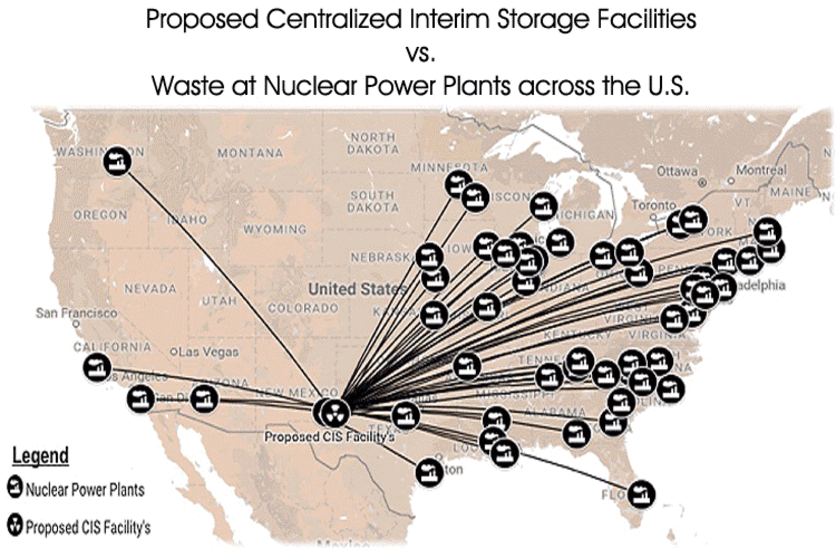
On Tuesday, June 23rd, the Nuclear Regulatory Commission (NRC) held a webinar and invited telephone comments on the Draft Environmental Impact Statement (DEIS) for a nuclear waste storage facility that Holtec proposes to build halfway between Carlsbad and Hobbs. Holtec applied for a license to store all of the nation’s most radioactive spent fuel from commercial nuclear power plants. Over twenty years, Holtec proposes to ship 10,000 canisters to the site by railroads, passing through more than forty states. https://www.nrc.gov/waste/spent-fuel-storage/cis/holtec-international.html, scroll down to Environmental Impact Statement.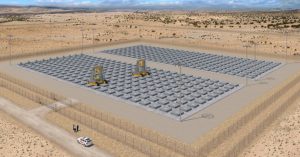
In 2012, officials in Eddy and Lea counties announced that a private company would submit a license application in March 2013. In December 2015, Holtec told the NRC that it would submit the license application in June 2016, so that the facility could begin operating in 2020. The application was submitted in March 2017, and stated that NRC’s license would be issued in 2019 and that construction would begin by March 2020. https://wethefourth.org/
“Seventy-five years ago, President Truman gave himself exclusive power over nuclear war. Every president since has clung to it. It was bad policy then; it is inexcusable now. We no longer need to take these risks, and we can safely back away from the brink…
It is time to retire the nuclear button. No one should have the unchecked power to destroy the world.”
— William J. Perry & Tom Z. Collina
THE NEW YORK TIMES:
Who Can We Trust With the Nuclear Button? No One.
2019
Feds give Navajo uranium contract to firm with sketchy past
A High Country News investigation finds the EPA awarded Tetra Tech a contract despite knowing its subsidiary had likely engaged in data manipulation, false reporting and profiteering.
ARTICLE BY SUSIE NIELSEN | hcn.org
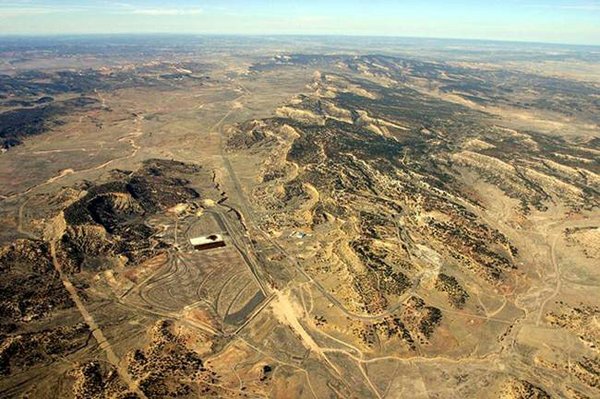
In September 2017, the Environmental Protection Agency received a troubling message from the Navy: Tetra Tech EC, the firm tasked with cleaning up the radioactive former naval shipyard Hunters Point in San Francisco, might have manipulated its data.
The past performance of Tetra Tech, even beyond its subsidiary at Hunters Point, has been marked by controversy. The parent company has been at the center of other lawsuits, including a consolidated case regarding its involvement in cleaning up after the North Bay Fires, a series of wildfires that devastated regions north of San Francisco in the fall of 2017.
“The Navajo Nation project is a bull’s-eye radioactive project with dangerous radioactivity. For Tetra Tech to get that project at all — to be even allowed to bid on it — is shocking.” – David Anton, attorney for the Tetra Tech EC whistleblowers
In 2008, the EPA and five other federal agencies, in consultation with Navajo Nation, developed the first comprehensive plan to address the legacy of uranium contamination in and around the Navajo Nation. As of 2014, of the 43 highest-priority Navajo Nation mines as designated by the EPA, only one of them — the Skyline Mine — had been mostly cleaned up.
Energy Secretary Rick Perry To Resign
NPR ALL THINGS CONSIDERED JEFF BRADY | npr.org Updated at 6:30 p.m. ET
Secretary of Energy Rick Perry plans to leave his position at the end of the year, President Trump confirmed to reporters Thursday in Fort Worth, Texas. Trump praised Perry and said he already has a replacement in mind.
“Rick has done a fantastic job,” Trump said. ” But it was time.”
Trump said that Perry’s resignation didn’t come as a surprise and that he has considered leaving for six months because “he’s got some very big plans.”
Perry, 69, is one of Trump’s original Cabinet members and recently has emerged as a central figure in the impeachment inquiry of Trump.
Urgent: Move US Nuclear Weapons Out Of Turkey
BLOG BY HANS M. KRISTENSEN | fas.org
A US Navy aircraft flies over Incirlik airbase in Turkey.Should the U.S. Air Force withdraw the roughly 50 B61 nuclear bombs it stores at the Incirlik Air Base in Turkey? The question has come to a head after Turkey’s invasion of Syria, Erdogan’s increasingly authoritarian leadership and deepening discord with NATO, Trump’s inability to manage U.S. security interests in Europe and the Middle East, and war-torn Syria only a few hundred miles from the largest U.S. nuclear weapons storage site in Europe.
The US is rethinking the 50-plus nuclear weapons it keeps in Turkey
“The US is storing perhaps 50 air-dropped thermonuclear bombs at its Incirlik Airbase in southern Turkey, less than 100 miles from the Syrian border where this conflict is taking place.”
BY: TIM FERNHOLZ | qz.com
Turkish forces are pushing into northern Syria, replacing and sometimes even firing on the US troops retreating at Donald Trump’s orders.
The question of whether Turkey, a member of the North Atlantic Treaty Organization, is really a US ally was put to US defense secretary Mark Esper on Fox television this morning. “No, I think Turkey, the arc of their behavior over the past several years has been terrible,” he said.
The nuclear stockpile dates back to the Cold War, when the US sought to keep a sufficient supply of atomic weapons deployed in Europe to deter potential Soviet aggression. Belgium, the Netherlands, Germany, and Italy also host similar arsenals, and the US trains the participating nations in the use of the doomsday devices.
Turkey Troubles
October 15 Heather Hurlburt, director of the New Models of Policy Change project at New America’s Political Reform program, joins Michelle Dover for a discussion on US national security and foreign policy under President Donald Trump. She is the co-author of The Consensual Straitjacket: Four Decades of Women in Nuclear Security.
News analysis with Michelle Dover, John Carl Baker and Geoff Wilson of Council for a Livable World focuses on the Trump administration’s decision to withdraw US troops from the Turkey-Syria border. Joe Cirincione answers a question from Johnny from Massachusetts.
Listen, Subscribe and Share on iTunes · Spotify · SoundCloud · YouTube · Google Play · Sticher
Also available on ploughshares.org/pressthebutton
Even a limited nuclear war between India and Pakistan could induce nuclear winter, thereby potentially killing 100’s of millions beyond South Asia.
From study: “Rapidly expanding nuclear arsenals in Pakistan and India portend regional and global catastrophe”
What if We Nuke a City?
“The world has changed in the past few years with world leaders again explicitly and publicly threatening each other with nuclear weapons. Many experts think the danger of a nuclear strike is higher than it has been in decades.
Governments tell their citizens that it’s good that we have nuclear weapons, but bad when others have them; that it’s somehow necessary to threaten others with mass destruction to keep us safe. But does this make you feel you feel safe? It only takes a small group of people in power to go crazy or rouge, a small misstep or simple misunderstanding to release a catastrophe of unimaginable proportions.”
Kurzgesagt – In a Nutshell
Video Description: “Until we did the research. It turned out we were a bit oblivious off the real impact of nuclear weapons in the real world, on a real city. And especially, how helpless even the most developed nations on earth would be if an attack occurred today. So hopefully this video demonstrates how extremely non fun a real world nuclear attack would be, without being too gruesome.”
DOE Order 140.1: DNFSB Response, Oct. 11
Chair Hamilton responds, “Pursuant to our enabling legislation, we have directed our staff to attend all phases of the NES study process. Should you wish to prohibit our access to a particular study, we respectfully request written communication to the Board.”
[NES = the nuclear explosive safety (NES) elements of DOE O 452.1E, Nuclear Explosive and Weapon Surety Program]
Oct. 11, 2019
The Honorable James Richard Perry Secretary of Energy
U.S. Department of Energy
1000 Independence Avenue, SW Washington, DC 20585-1000
Dear Secretary Perry:
We have received NNSA’s response dated August 9, 2019, concerning Board access to all phases of the nuclear explosive safety study process. We respectfully disagree with the justification offered for continued exclusion of our staff from NES study deliberations. NNSA’s response notes deliberations as collaborative efforts where participants consider all sides of identified issues, requiring free and open communication. Our staff’s observation of this interaction provides them with an understanding of the bases of the safety decisions being taken.
Public Event – Rocky Flats Disaster: Red Light for SRS Plutonium Bomb Plant
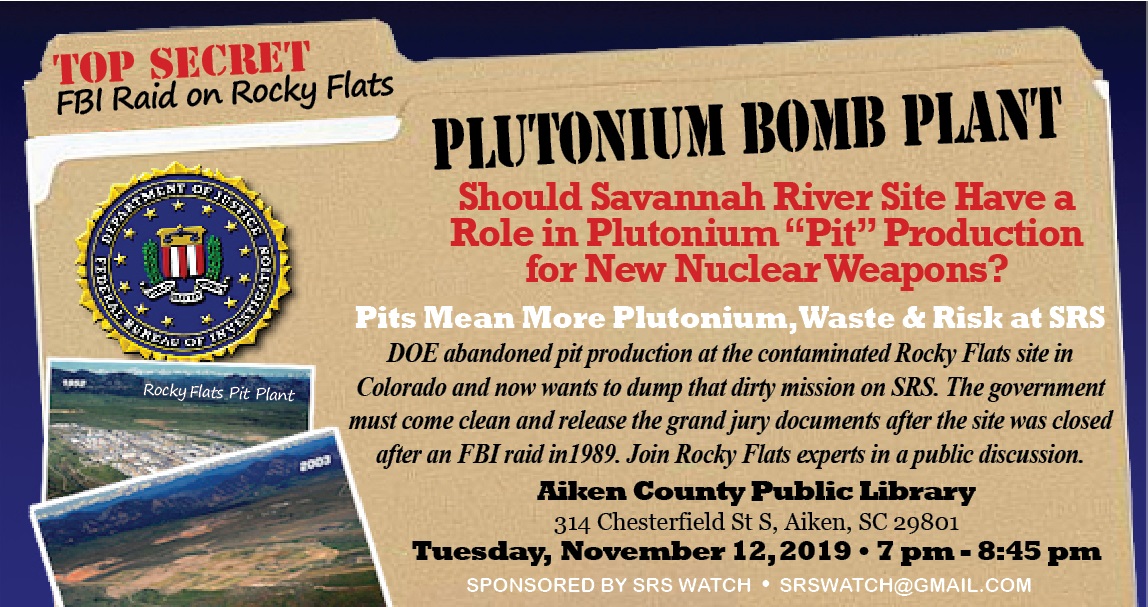
Speakers: Dr. LeRoy Moore and Patricia Mellen, Esq, who is trying to get grand jury documents about the FBI raid released on behalf of the Rocky Mountain Peace and Justice Center and other groups.
Read LeRoy’s new book: “Plutonium & People Don’t Mix: Rocky Flats: Colorado’s Defunct Nuclear Bomb Factory.”
View article by LeRoy: Rocky Flats refuge opening disregards evidence of risk
2018
“As long as nuclear weapons exist, there is a risk that they could be used- by accident, via a technical failure, or though the evil will of a man, madmen or terrorists. A nuclear-free world is not a utopia, but an imperative. Yet it can be achieved only through the demilitarization of international relations.”
-Mikhail Gorbachev, speaking in Reykjavik, marking the 30th anniversary of the 1986 Soviet-American summit.
“I know not with what weapons World War III will be fought, but World War IV will be fought with sticks and stones.”
-Albert Einstein
“The release of atomic power has changed everything except our way of thinking … the solution to this problem lies in the heart of mankind. If only I had known, I should have become a watchmaker.”
-Albert Einstein
There are two problems for our species’ survival – nuclear war and environmental catastrophe – and we’re hurtling towards them. Knowingly.
– Noam Chomsky
Kirtland AFB Official News Paper
Find online here.
General Omar Bradley
“Ours is a world of nuclear giants and ethical infants. We know more about war than we know about peace, more about killing than we know about living. We have grasped the mystery of the atom and rejected the Sermon on the Mount.”
-Gen. Omar Bradley
Colin Powell
“Today I can declare my hope, and declare it from the bottom of my heart, that we will eventually see the time when the number of nuclear weapons is down to zero and the world is a much better place.”
Jay Coghlan
Jay Coghlan, Executive Director of Nuclear Watch New Mexico, commenting on the Supplemental Environmental Impact Statement for the proposed Chemistry and Metallurgy Research Replacement (CMRR) Nuclear Facility in the plutonium production complex at Los Alamos National Laboratory.
2017
How US Nuclear Force Modernization is Undermining Strategic Stability
A must read:
Nuclear Weapons defects graph from 1993 Sandia Stockpile Life Study
How US Nuclear Force Modernization is Undermining Strategic Stability:
The Burst-Height Compensating Super-Fuze
By Hans M. Kristensen, Matthew McKinzie, Theodore A. Postol
https://web.archive.org/web/20180623204508/https://thebulletin.org/how-us-nuclear-force-modernization-undermining-strategic-stability-burst-height-compensating-super10578
Excerpt:
“The US nuclear forces modernization program has been portrayed to the public as an effort to ensure the reliability and safety of warheads in the US nuclear arsenal, rather than to enhance their military capabilities. In reality, however, that program has implemented revolutionary new technologies that will vastly increase the targeting capability of the US ballistic missile arsenal. This increase in capability is astonishing- boosting the overall killing power of existing US ballistic missile forces by a factor of roughly three- and it creates exactly what one would expect to see, if a nuclear-armed state were planning to have the capacity to fight and win a nuclear war by disarming enemies with a surprise first strike.”
This is a super outstanding analysis by Mssrs. Kristensen, McKinzie and Postol. I’m no doubt naïve, but I’m hoping it will have some real political and geopolitical impact.
And how in keeping with the 2013 Defense Dept. guidance, which Kristensen was the first to point out to me. It helps to demonstrate that the American public doesn’t really have nuclear “deterrence” as claimed for a half-century. Instead, the U.S. has always had a nuclear war-fighting strategy, as first demonstrated in Hiroshima and Nagasaki.
To quote:
The new guidance requires the United States to maintain significant counterforce capabilities against potential adversaries. The new guidance does not rely on a “counter-value’ or “minimum deterrence” strategy.
Report on Nuclear Implementation Strategy of the United States Specified in Section 491 of 10. U.S.C., Department of Defense, June 2013, page 4 (quotation marks in the original) http://www.globalsecurity.org/wmd/library/policy/dod/us-nuclear-employment-strategy.pdf
As Kristensen, McKinzie and Postol point out, the geopolitical risks in radical improvements to U.S. nuclear warfighting capabilities are enormous. A secondary concern I’d like to point out is the risk to nuclear weapons reliability posed by intentionally introducing major changes to an extensively tested stockpile.
The Pantex Plant (final assembly site for US nuclear weapons) has a newsletter called The Pantexan (duh!). I recall circa 2009 that it had an article concerning the fact that the MC 4700 “super fuze” that was being installed in the then-ramping up W76 Life Extension Program had initial design and production problems. As the article boasted, those defects were detected and swiftly corrected.
However, the principle remains that introducing intentional changes can undermine confidence in stockpile reliability. The grand irony is that the Stockpile Stewardship Program has been lavishly funded because of the official rationale of preserving stockpile reliability, but I believe it has been a Trojan horse all along for using Life Extension Programs to create new military capabilities (and which the excellent analysis above reinforces).
[I have tried a few times to again find that Pantexan article, unfortunately without success.]
Below is a graph (pending) from the 1993 Sandia Stockpile Life Study which shows that the supermajority of nuclear weapons defects occur within the first 5 years from the First Production Unit. Marylia Kelley (Executive Director of TriValley CAREs that watchdogs Livermore Lab ) and I met with Vic Reis, commonly regarded as the “father” of the Stockpile Stewardship Program, in 2004 or 2005. He explicitly said to us that the whole purpose of the Stockpile Stewardship Program was for the “other side of the bathtub curve”, i.e. when defects were going to multiply because of aging.
Guess what? That hasn’t happened, given long-established stockpile surveillance, rigorous maintenance and well-understood replacement of “limited life components” (e.g., batteries, neutron generators, tritium).
Indeed, the 1993 Sandia Stockpile Life Study itself said
We undertook this study to understand how long nuclear weapons last. We quickly learned that this is the wrong question. It is clear that, although nuclear weapons age, they do not wear out; they last as long as the nuclear weapons community (DOE and DOD) desire. In fact, we can find no example of a nuclear weapon retirement where age was ever a major factor in the retirement decision.
The more significant question is “what does it take to sustain a weapon while it is in the stockpile?”… Failures, defects, and aging problems have been rare…
[Available at https://nukewatch.org/facts/nwd/Sandia_93_StockpileLife.pdf]
So again, I think the Stockpile Stewardship Program has been a ruse to indefinitely preserve U.S. nuclear weapons while giving them new military capabilities. And now we have the trillion dollar-plus “modernization” to vastly expand U.S. nuclear warfighting capabilities.

Russia Violates Important Arms Control Treaty, While US Presses Ahead With Destabilizing Strategic Advantages
There is this important article today:
US General Says Russia Has Deployed Banned Missile
WASHINGTON — A senior U.S. general on Wednesday accused Russia of deploying a land-based cruise missile in violation of “the spirit and intent” of a nuclear arms treaty and charged that Moscow’s intention is to threaten U.S. facilities in Europe and the NATO alliance.
“We believe that the Russians have deliberately deployed it in order to pose a threat to NATO and to facilities within the NATO area of responsibility,” Gen. Paul Selva, vice chairman of the Joint Chiefs of Staff, told a House Armed Services Committee hearing….
Nuclear Watch New Mexico definitely takes treaty violations seriously. But left unsaid is the fact that the US is acquiring 1,000 new nuclear-armed cruise missiles permitted under New START, which because of that, despite what Trump says, is a better deal for the US than Russia.
Then there is the pending forward deployment in Europe of new B61-12s with new military capabilities (the world’s first “smart” nuclear bomb), plus the ongoing increase in hard target kill capability “boosting the overall killing power of existing US ballistic missile forces by a factor of roughly three…”, as so well recently explained by Kristensen, McKinzie and Postal. See https://web.archive.org/web/20180623204508/https://thebulletin.org/how-us-nuclear-force-modernization-undermining-strategic-stability-burst-height-compensating-super10578
Then there is American chest thumping about new threats to NATO, but left unsaid is NATO expansionism to the borders of Russia; and American abrogation of the ABM Treaty, leading to ballistic missile defenses in Europe that could destabilize “deterrence.”
Yes, treaties are essential, but as usual hard nosed military capabilities unfortunately rule the day. It’s a wonder that Russia’s nuclear posture isn’t actually more aggressive than it is in the face of new American threats.
Of course the nuclear weapons states are pretty hopeless, as the United States and Russia spiral into a new nuclear arms race. Something new is needed.
We are curious as to where the pending nuclear weapons ban treaty negotiations might go and what impact they might have. More to come, as NukeWatch director Jay Coghlan observes the first week of negotiations March 27-31 at the United Nations in New York City.
Costs Jump in Nuclear Weapons vs. Cleanup; Nuclear Weapons Winning over Environmental Protection
America is at a crossroads, having to choose between an unnecessarily large, exorbitant, nuclear weapons stockpile, and cleanup that would protect the environment and water resources for future generations. Expanded nuclear weapons research and production, which will cause yet more contamination, is winning.
Two recently released government reports make clear the stark inequality between the so-called modernization program to upgrade and indefinitely preserve U.S. nuclear forces (in large part for a new Cold War with Russia), and the nation-wide program to clean up the radioactive and toxic contamination from the first Cold War. The Obama Administration launched a trillion dollar nuclear weapons “modernization” program, which President Trump may expand. In contrast, cleanup of the first Cold War mess has been cut from a high of $8.5 billion in 2003 to $5.25 billion in 2016, even though comprehensive cleanup would produce far more jobs than nuclear weapons programs.
With respect to cleanup, last week the Congressional Government Accountability Office (GAO) released its bi-annual High-Risk Series, which added “Environmental Liabilities” to its list of federal programs and operations that are particularly susceptible to fraud, waste, abuse, and mismanagement. Environmental liabilities are expressed as the estimated taxpayers’ cost of necessary future cleanup.
The Department of Energy is running the world’s largest cleanup program addressing the massive contamination caused by Cold War nuclear weapons research and production. But that national program is plagued by inefficiencies, mismanagement, cost overruns and excessive contractor profits.
According to GAO, since 1989 DOE’s Office of Environmental Management has spent over $164 billion on cleanup. Nevertheless, “Despite billions spent on environmental cleanup, DOE’s environmental liability has roughly doubled from a low of $176 billion in fiscal year 1997 to the fiscal year 2016 estimate of $372 billion.”
Therefore, from a cost perspective, cleanup is going backwards fast. Moreover, that $372 billion won’t be anywhere near the total cost of comprehensive, genuine cleanup because not all contamination is yet known. Furthermore, DOE explicitly plans to “cap and cover” much of its existing buried radioactive and toxic wastes, creating de facto permanent nuclear waste dumps while declaring them cleaned up according to regulations.
In contrast, funding is rapidly rising for revamped nuclear weapons and the missiles, submarines and bombers to deliver these most formidable weapons of mass destruction. Underpinning this astronomical expense is the fact that instead of maintaining just the few hundred warheads needed for the publicly claimed policy of “deterrence,” thousands of warheads are being refurbished and kept to fight a potential nuclear war. This is the little known but explicit policy of the U.S. government. As a top-level 2013 Defense Department policy document put it, “The new guidance [in Obama’s 2010 Nuclear Posture Review] requires the United States to maintain significant counterforce capabilities against potential adversaries. The new guidance does not rely on a “counter-value’ or “minimum deterrence” strategy.”
President Reagan said long ago that nobody can win a nuclear war. Thousands of nuclear weapons are certainly not needed to deter emerging nuclear threats such as North Korea or potential nuclear terrorism. In addition, there are increasing hints (for example, by the Defense Department’s Defense Science Board) that the U.S. may develop and produce more precise low-yield nuclear weapons that are arguably more usable, and even possibly return to full-scale testing.
Expanded U.S. nuclear capabilities under the rubric of “modernization” involves the wholesale rebuilding of DOE’s nuclear weapons production complex; a perpetual cycle of Life Extension Programs that refurbish existing nuclear weapons while giving them new military capabilities; and completely new ballistic missiles, cruise missiles, heavy bombers and submarines to deliver the rebuilt nuclear weapons.
Not surprisingly, that’s going to cost American taxpayers more than previously thought. Last week the nonpartisan Congressional Budget Office (CBO) released its updated study Projected Costs of U.S. Nuclear Forces, 2017 to 2026. It estimated that “modernization” of the U.S. nuclear forces will cost $400 billion during 2017 to 2026. This is 15% higher than a CBO estimate two years ago of $348 billion for the 10-year period of 2015 to 2024.
Moreover, in its earlier report CBO asserted that the next two decades will cost even more. Therefore, modernization will exceed the one trillion dollars over 30 years that is often cited now. And that figure could go much higher yet should Trump accelerate modernization, which he implied when he tweeted the U.S. “must greatly strengthen and expand its nuclear capability…”
Common to both its nuclear weapons and cleanup programs, DOE has the singular distinction of having its contract management designated as high risk by GAO for 26 consecutive years. This is because the Department’s track record of inadequate management and oversight of contractors, who comprise 95% of all nuclear weapons complex employees, has left DOE vulnerable to fraud, waste and abuse. The list of busted projects is overwhelming, while the usual nuclear weapons contractors are typically not held accountable (for example, Bechtel’s Waste Treatment Plant at Hanford or Babcock and Wilcox’s half-billion dollar design mistake for Y-12’s proposed Uranium Processing Facility).
To illustrate this nation-wide problem locally, the Los Alamos National Laboratory (LANL), run by Bechtel and the University of California, recently signed a new 2016 Consent Order governing cleanup with the New Mexico Environment Department (NMED), which has coddled the nuclear weapons industry under Gov. Martinez. This new agreement pushes completion of Lab cleanup out to 2040, while creating loopholes where DOE can get out of cleanup by simply claiming that it is too difficult or costly. As a result, DOE has cut the Lab cleanup budget to around $188M per year, in contrast to a high of $225 million in 2014, or the $250 million per year that NMED has said in the past is necessary.
To add insult to injury, LANL’s estimated 3-4 billion dollar environmental liability assumes that nearly 200,000 cubic meters of radioactive and hazardous wastes are left behind forever in unlined dumps, protected only by “cap and cover” and thereby “cleaned up” according to regulations. But this, of course, is false cleanup. As a 2005 LANL hydrogeological report put it, “Future contamination at additional locations [in regional groundwater] is expected over a period of decades to centuries as more of the contaminant inventory reaches the water table.”
But nuclear weapon research and production at LANL, which threatens precious water resources, is not only thriving, but is expanding. Currently, up to $6 billion is planned to be spent on upgrading existing plutonium facilities and building new ones so that production can be expanded to 50-80 plutonium pits per year by 2028 (pits are the fissile cores of nuclear weapons). Ironically, expanded pit production is for exorbitant “Interoperable Warheads” for both intercontinental ballistic missiles and sub-launched missiles that the nuclear weapons labs are pushing but the Navy doesn’t want. Moreover, the planned changes to the existing, extensively tested nuclear stockpile are so radical that they could undermine confidence in performance reliability, possibly prompting a return to full scale testing.
Scott Kovac, Research Director at Nuclear Watch NM, commented, “Ten years from now, after taxpayers spend another $50 billion on cleanup, DOE’s environmental liability estimate will probably still be more than $400 billion. Meanwhile the US will have spent the same amount on expanded nuclear weapons production that will cause yet more contamination. That money should instead be used to get cleanup done once and for all, giving American taxpayers the real national security of a clean environment and safe drinking water.”
Jay Coghlan, Nuclear Watch New Mexico Executive Director, observed, “Over the next few decades the window will close for comprehensive, genuine cleanup. Unfortunately, our children and grandchildren will instead be saddled with the ongoing financial and environmental debts of never-ending improvements to nuclear weapons that keep a privileged elite rich. As citizens we need deep and meaningful contractor reform and stronger federal oversight. The directors of the nuclear weapons labs should be stripped of their two-hatted role as the presidents of the for-profit limited liability corporations that run the labs, which are built-in conflicts-of-interest. Then perhaps we would begin to see jobs-creating cleanup programs taking precedence over unneeded, exorbitant nuclear weapons programs that threaten global security and local environments.”
###
GAO High-Risk Series 2017 is available at http://www.gao.gov/products/GAO-17-317
Specific DOE cleanup cost numbers are at http://gao.gov/highrisk/us_government_environmental_liability/why_did_study#t=1
Projected Costs Of U.S. Nuclear Forces, 2017 To 2026 February 2017 is available at https://www.cbo.gov/sites/default/files/115th-congress-2017-2018/reports/52401-nuclearcosts.pdf
The quote on top-level counterforce nuclear weapons doctrine is from:
Report on Nuclear Implementation Strategy of the United States Specified in Section 491 of 10. U.S.C., Department of Defense, June 2013, page 4 (quotation marks in the original) http://www.globalsecurity.org/wmd/library/policy/dod/us-nuclear-employment-strategy.pdf
For possible more usable nuclear weapons and a return to full-scale testing, see Seven Defense Priorities for the New Administration, Defense Science Board, December 2016, http://www.acq.osd.mil/dsb/reports/Seven_Defense_Priorities.pdf
The quote on more expected groundwater contamination is from LANL’s Hydrogeologic Studies of the Pajarito Plateau: A Synthesis of Hydrogeologic Workplan Activities (1998–2004), ER2005-0679 December 2005, Page 5-15, http://www.worldcat.org/title/los-alamos-national-laboratorys-hydrogeologic-studies-of-the-pajarito-plateau-a-synthesis-of-hydrogeologic-workplan-activities-1998-2004/oclc/316318363
How US Nuclear Force Modernization is Undermining Strategic Stability: The Burst-Height Compensating Super-Fuze
The US nuclear forces modernization program has been portrayed to the public as an effort to ensure the reliability and safety of warheads in the US nuclear arsenal, rather than to enhance their military capabilities. In reality, however, that program has implemented revolutionary new technologies that will vastly increase the targeting capability of the US ballistic missile arsenal. This increase in capability is astonishing- boosting the overall killing power of existing US ballistic missile forces by a factor of roughly three- and it creates exactly what one would expect to see, if a nuclear-armed state were planning to have the capacity to fight and win a nuclear war by disarming enemies with a surprise first strike.
The revolutionary increase in the lethality of submarine-borne US nuclear forces comes from a ‘super-fuze’ device that since 2009 has been incorporated into the Navy’s W76-1/Mk4A warhead as part of a decade-long life-extension program. We estimate that all warheads deployed on US ballistic missile submarines now have this fuzing capability. Because the innovations in the super-fuze appear, to the non-technical eye, to be minor, policymakers outside of the US government (and probably inside the government as well) have completely missed its revolutionary impact on military capabilities and its important implications for global security…
The W76 upgrade reflects a 25-year shift of the focus of US hard-target kill capability from land-based to sea-based ballistic missiles. Moreover, by shifting the capability to submarines that can move to missile launch positions much closer to their targets than land-based missiles, the US military has achieved a significantly greater capacity to conduct a surprise first strike against Russian ICBM silos…
In spite of its severe limitations, this growing defense system could appear to both Russia and China as a US attempt to reduce the consequences of a ragged Russian or Chinese retaliation to a US first strike against them.
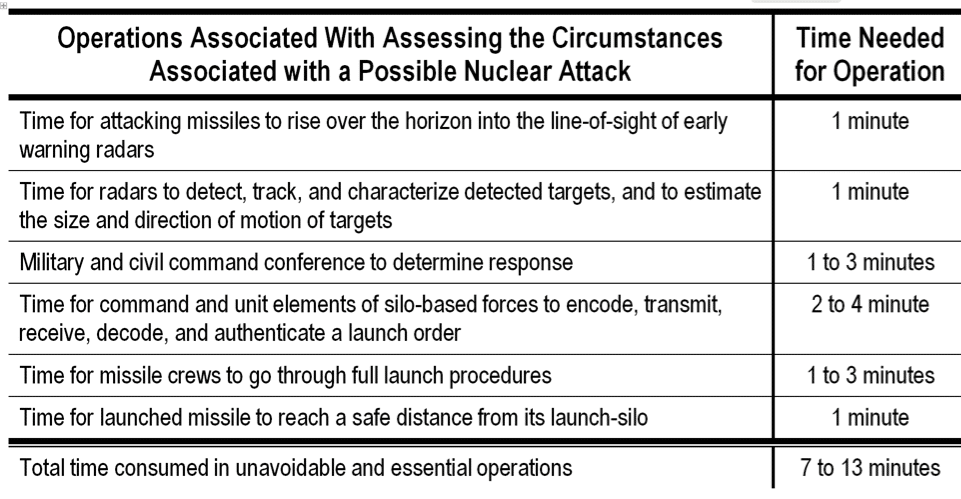
We cannot foresee a situation in which a competent and properly informed US president would order a surprise first strike against Russia or China. But our conclusion makes the increased sea-based offensive and defensive capabilities we have described seem all the more bizarre as a strategy for reducing the chances of nuclear war with either Russia or China…”
-Hans M. Kristensen, Matthew McKinzie, Theodore A. Postol from The Bulliten of Atomic Scientists
Defense Science Board Recommends “A More Flexible Nuclear Enterprise”
Sometimes, maybe, the status quo is something we need to safeguard, not disrupt. That may be the case when it comes to a new push to abandon the US-Russian mutual prohibition on the deployment of low-yield nuclear weapon systems as part of theater warfighting doctrine.
Since the late 1980s both US and Soviet, now Russian, policy has been to not develop and deploy ‘tactical’ nuclear weapons, including theater-range missiles, because it was agreed that it would be very difficult to prevent a ‘tactical’ exchange in a regional conflict from progressing rapidly to a civilization-ending ‘strategic’ exchange.
But new doubts are arising about the credibility of a strategic deterrent in the case of a local or regional conflict: one which, for example, the US could be involved in, even though the stakes may not put essential US security at risk. In such cases, some US warfighters would like to have the option of threatening counterforce and intermediate range strikes using low-yield nukes. Or, they argue, what if an adversary uses a tactical nuke to “escalate to de-escalate”? Some want to be able to respond in kind. These doubts about classical deterrence, along with a ‘multipolar’ landscape of nuclear-armed states, are the basis for the nuclear boosters’ meme of “The Second Nuclear Age”).
See Pentagon Panel Urges Trump Team to Expand Nuclear Options
Plutonium Pit Production at LANL
Summary
Plutonium pit production is a chokepoint of resumed U.S. nuclear weapons production. Citizens have defeated four past government attempts to expand pit production. Now Trump promises to increase military spending, and Congress has already required expanded pit production at the Los Alamos Lab regardless of the technical needs of the stockpile. This will enable the continuing evolution of the U.S. nuclear weapons stockpile with new military capabilities. Trump’s pending federal budget will likely fund new and upgraded plutonium facilities expected to be operational for at least the next half-century. Continue reading
Costs Jump in Nuclear Weapons vs. Cleanup; Nuclear Weapons Winning over Environmental Protection
Santa Fe, NM.
America is at a crossroads, having to choose between an unnecessarily large, exorbitant, nuclear weapons stockpile, and cleanup that would protect the environment and water resources for future generations. Expanded nuclear weapons research and production, which will cause yet more contamination, is winning.
Two recently released government reports make clear the stark inequality between the so-called modernization program to upgrade and indefinitely preserve U.S. nuclear forces (in large part for a new Cold War with Russia), and the nation-wide program to clean up the radioactive and toxic contamination from the first Cold War. The Obama Administration launched a trillion dollar nuclear weapons “modernization” program, which President Trump may expand. In contrast, cleanup of the first Cold War mess has been cut from a high of $8.5 billion in 2003 to $5.25 billion in 2016, even though comprehensive cleanup would produce far more jobs than nuclear weapons programs.
“Astoundingly High” Radiation Levels Detected at Fukushima Unit 2
The radiation level in the containment vessel of reactor two has reached as high as 530 sieverts per hour, Tokyo Electric Power Co, or Tepco as it’s known, said last week.
Are levels rising?
Azby Brown reporting on Safecast’s website, February 4th:
No, radiation levels at Fukushima Daiichi are not rising
“It must be stressed that radiation in this area has not been measured before, and it was expected to be extremely high. While 530 Sv/hr is the highest measured so far at Fukushima Daiichi, it does not mean that levels there are rising, but that a previously unmeasurable high-radiation area has finally been measured. Similar remote investigations are being planned for Daiichi Units 1 and 3. We should not be surprised if even higher radiation levels are found there, but only actual measurements will tell.” (see more at Safecast)
Feb. 8, Denver Post: Could the radiation level be even higher? Possibly. The 530 sievert reading was recorded some distance from the melted fuel, so in reality it could be 10 times higher than recorded, said Hideyuki Ban, co-director of Citizens’ Nuclear Information Center.
García-Robles’ Nobel Medal Sold at Auction
Alfonso García Robles drafted the 1967 Treaty for the Prohibition of Nuclear Weapons in Latin America and the Caribbean. He was awarded the Nobel Peace Prize in 1982. He died in 1991. The Treaty of Tlatelolco, as it became known, was the first of its kind and is credited with keeping Latin America and the Caribbean free of nuclear weapons.
As Trump Seeks to Expand U.S. Nuclear Weapons Capabilities New Sandia Labs Director Argued for Expanded Use of Nuclear Weapons
On December 22, 2016 president-elect Donald Trump upended four decades of U.S. policy to reduce nuclear weapons by tweeting “the United States must greatly strengthen and expand its nuclear capability until such time as the world comes to its senses regarding nukes.” The next morning he doubled down by declaring, “Let it be an arms race. We will outmatch them at every pass and outlast them all.”
That same day Russian President Vladimir Putin claimed that his country’s nuclear weapons are fully capable of penetrating any American missile defense system, and observed “It’s not us who have been speeding up the arms race.” Earlier Trump had suggested that Japan, South Korea and Saudi Arabia should perhaps obtain nuclear weapons, and reportedly asked a foreign policy advisor why the U.S. couldn’t use nuclear weapons if it already had them. Further, Trump refused to rule out using nuclear weapons in Europe or against the Islamic State in Iraq and Syria. Underlying all this is a trillion dollar effort begun under the Obama Administration to upgrade U.S. nuclear forces, including new nuclear weapons production plants, and new missiles, submarines and bombers, all expected to be operational until around the year 2080.
One of the most important players in the trillion dollar nuclear weapons upgrade is the Sandia National Laboratories, with its newly appointed director Stephen Younger. Long before Trump, Younger argued for the expanded use of nuclear weapons, writing in his June 2000 paper Nuclear Weapons in the 21st Century “[i]t is often, but not universally, thought that nuclear weapons would only be used in extremis, when the nation is in the gravest danger…..This may not be true in the future.” (P. 2)
Although generally the least publicly recognized of the three American nuclear weapons labs, Sandia is the largest by both budget and number of personnel (the other two nuclear weapons labs are the Los Alamos and the Lawrence Livermore National Laboratories). Sandia has multiple sites (hence is called “Labs” in the plural), but its main facility is on Kirtland Air Force Base in Albuquerque, NM. Nearby is the Kirtland Underground Munitions Maintenance and Storage Complex, likely the largest storage facility for nuclear weapons in the nation, with up to 2,500 warheads. Kirtland AFB also sites the Air Force’s national Nuclear Weapons Center, which describes itself as the “The Nucleus of America’s Deterrent”, whose stated mission is to “Deliver nuclear capabilities Warfighters use every day to deter and assure.”
Although “deterrence” has been sold to the American taxpayer for decades as the rationale for nuclear weapons, in reality the U.S. (and Russian) arsenal is for nuclear warfighting, as a 2013 top-level Pentagon document explicitly states:
The new guidance requires the United States to maintain significant counterforce capabilities against potential adversaries. The new guidance does not rely on a “counter-value’ or “minimum deterrence” strategy.
As one source explains
Counterforce doctrine, in nuclear strategy, [is] the targeting of an opponent’s military infrastructure with a nuclear strike. The counterforce doctrine is differentiated from the countervalue doctrine, which targets the enemy’s cities, destroying its civilian population and economic base. The counterforce doctrine asserts that a nuclear war can be limited and that it can be fought and won. https://www.britannica.com/topic/counterforce-doctrine
In turn, counterforce requires thousands of nuclear weapons for nuclear warfighting, instead of the few hundred needed for only deterrence. But as President Ronald Reagan famously put it in his 1984 State of the Union address:
A nuclear war cannot be won and must never be fought. The only value in our two nations possessing nuclear weapons is to make sure they will never be used. But then would it not be better to do away with them entirely?
In 1988 Reagan nearly reached agreement with Soviet Union leader Mikhail Gorbachev to ban nuclear weapons. Unfortunately, relying on false promises made by then-Livermore Lab Director Edward Teller, Reagan insisted on pursuing ballistic missile defenses (or “Star Wars”), which killed any possible deal. Thus, sadly, counterforce and the capability to wage a nuclear war remain the operative national security policy as we face today’s very real risk of entering into a new nuclear arms race with Russia.
Stephen Younger already foreshadowed this in his 2000 paper when he wrote, “The United States employs a counterforce strategy that targets military assets that could inflict damage to our national interests.” (P. 9) He is now in a prime position to implement that counterforce policy as Sandia Labs Director.
Sandia’s main mission is design of the thousands of nonnuclear components (such as fuzes, radars, etc.) that weaponize the nuclear designs of the Los Alamos and Lawrence Livermore National Laboratories into deliverable weapons of mass destruction. However, Sandia’s secondary mission is studying nuclear weapons “effects,” which are not the horrific effects of nuclear weapons on humans and the environment. Instead, this concerns the effects of nuclear weapons on nuclear weapons, to make sure that they are radiation hardened so that they will operate in the severe environments of a nuclear war. This is aimed at mostly the fratricidal effects of our own weapons, since any single target might be hit with multiple warheads. This has every thing to do with nuclear warfighting and first strike capabilities, rather than mere “deterrence.”
Younger’s appointment as director is also indicative of Sandia’s growing focus on nuclear weapons, principally due to Life Extension Programs (LEPs) that not only seek to indefinitely preserve existing nuclear weapons, but to also give them new military capabilities (Sandia is currently the lead lab for the B61-12 LEP, which is transforming a “dumb” bomb into the world’s first nuclear smart bomb). A decade ago Sandia Labs fell below 50% funded by nuclear weapons programs, which was publicly touted by the New Mexican congressional delegation as successful mission diversification leading to possible greater regional economic development. However, that trend is now reversed. In the FY 2017 federal budget request Sandia is 56% funded by nuclear weapons programs. In terms of gross funding for nuclear weapons programs Sandia is tied with the Los Alamos Lab at $1.58 billion for FY 2017, while Lawrence Livermore Lab’s nuclear weapons program is $1.07 billion. Sandia’s total annual budget is around $2.8 billion, the largest of the three nuclear weapons labs.
Jay Coghlan, Nuclear Watch New Mexico Director, commented, “Americans can’t allow an unpredictable president and a greedy nuclear weapons complex to fool us into a new nuclear arms race. Reagan said it best that “a nuclear war cannot be won and must never be fought.” We need to make sure that Trump gets that message as well. He says he wants to both rebuild the nation’s infrastructure and expand nuclear weapons capabilities. But it’s one or the other – Trump will find out the hard way that the country can’t afford to have it both ways.”
# # #
Stephen Younger’s June 2000 paper “Nuclear Weapons in the 21st Century” is available at https://nukewatch.org/importantdocs/resources/NuclearWeaponsIn21stCentury.pdf
For more on the Kirtland Air Force Base, the nuclear weapons complex within the nuclear weapons complex, please see https://nukewatch.org/Kirtland.html
The quote on U.S. nuclear weapons counterforce policy is from: Report on Nuclear Implementation Strategy of the United States Specified in Section 491 of 10. U.S.C. Department of Defense, June 2013, page 4 (quotation marks in the original) http://www.globalsecurity.org/wmd/library/policy/dod/us-nuclear-employment-strategy.pdf
2016
Nothing Found
It seems we can’t find what you’re looking for. Perhaps searching can help.
2015
Nothing Found
It seems we can’t find what you’re looking for. Perhaps searching can help.



